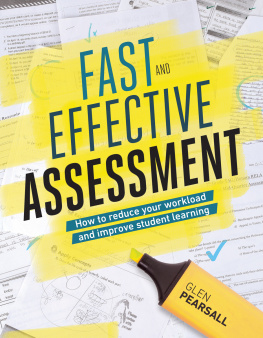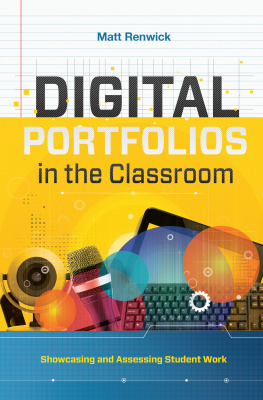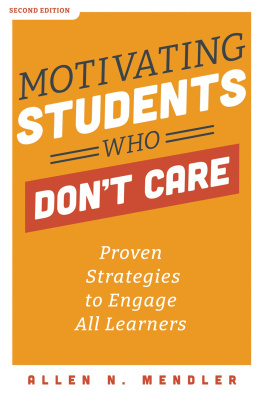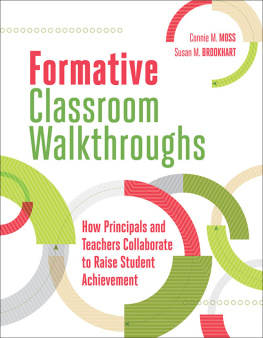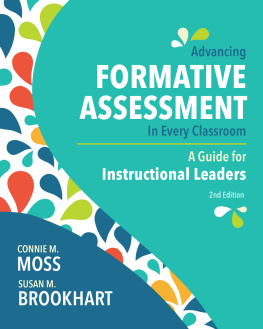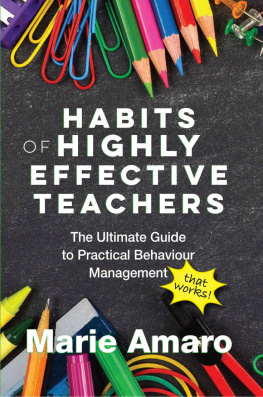Contents
Guide
Pages


Dedication
....................
To Noah and Jem for trying to be patient while I was "upstairs still writing that book," to Mum and Dad, and to Tash, my favorite reader
Acknowledgments
....................
Thanks to Hermina Burns, Bryan Goodwin, Rai Jones, Martin Jorgensen, Nicole Trethowan, Michael Victory, and my editors at ASCD. Thanks also to staff and students at Eltham High School and all the other schools who have been so gracious as to let me into their classroomsparticularly those at schools such as Mt. Ridley College P12 who have been brave enough to share and review their work with me on video. Special thanks to Tashy for her detailed feedback, thoughtful advice, and much better grammar.
Introduction
....................
The first time I ever assigned work to students as a new teacher, I was ready for them to not have completed their workand to have all manner of excuses (though the breadth and creativity of these excuses were impressive). What surprised me was how impatient students were to get the work back. Almost from the moment they handed the work to me, students were asking, "What did I get?" and "Have you marked the assignments?" This included the students who handed the work in late andremarkablyone student who hadn't handed in the work at all.
When I returned the work a couple of days later ("Finally!" observed one student, who'd given me his work that very morning, two days late), I was eager to see how they would respond to all my feedback, particularly because I'd set aside some personal obligations to get the work back quicker than I originally planned and had meticulously annotated each piece with detailed advice.
The students were largely indifferent to my efforts. They quickly checked their grades, and only some gave the comments a cursory glance before putting the work back in their folders. A little perturbed, I debriefed with my colleagues in the staff room: Did it always take so long to mark the work? Was it always so hard to get students to take your advice? ("Welcome to teaching!" one dryly observed.) Their advice in response was both helpful and honest: I would get better and quicker at it with practice, but the workload related to correcting student work and providing feedback was always demanding.
When you start out as a teacher, the demands of assessment can be utterly overwhelmingit felt to me like trying to drink from a fire hose. However, it is not just those in their first few years of teaching who struggle with the demands associated with feedback and correction. Teachers at all levels of experience wrestle with this issue. "It's hard to focus on your students' needs," one teacher confided to me, "when your view is obscured by piles of marking."
Providing helpful feedback and creating meaningful assessment tasks while keeping up with reviewing and correcting student work (let alone balancing your work life and your personal life) is one of the biggest challenges of teaching. Fast and Effective Assessment offers teachers a systematic way to approach this problem. Each of the six chapters lays out key strategies for improving the quality of feedback your students receive while reducing the time and effort you spend on generating this feedback.
In we explore how to refine your questioning technique. Teachers question students at every stage of assessment, from quizzing them for prior knowledge before starting a topic to asking them to reflect on their final results, so refining your questioning can have a profound effect on every aspect of learning. Using questioning to quickly check on your students' progress and offer them some in-the-moment feedback saves you from having to do this via more laborious and time-intensive written assessment. These refinements require only small adjustments of technique and a little additional planning and preparation. They are an excellent introduction to how you can improve your assessment and feedback practices without adding to your workload.
Feedback works best when your students have a precise sense of what they are trying to learn. If they know where they are going, then their feedback to you about their progress is more accurate and your advice to them about what they need to do to reach their goals is more relevant. In we discuss how, more than just telling students where they are headed, we need them to internalize these goals. When students understand what is required of them, they are much more active in giving and responding to feedback and you can target your efforts on what will help them most. This chapter gives you a range of practical strategies for encouraging your students to take ownership of their learning goals.
Once you and your students have established what they are learning, you need strategies for checking on their progress toward this goal. Most of the traditional ways we check on our students' learning involve collecting and correcting large amounts of student work, but I'm interested in ways to avoid unnecessary work for teachers. In we look at quick techniques for finding out what your students know and what they are struggling with. We want a tighter feedback cycle so students aren't waiting to get a piece of written work back to know what they need to work on next. This chapter details a series of fast formative assessment strategies that you can use to check and correct during class time instead of having to add more to your correction pile.
Summative testing is one of the most common ways that teachers assess student progress. However, waiting until the end of a unit to assess your students' progress is often counterproductiveyou don't want to give students feedback only after their learning on the topic is finished. explores how you can modify traditional testing strategies to provide quick and reliable methods for monitoring your students' ongoing progress. These tests are fast and accurate, and they give you a way to provide formative feedback to your students without requiring extensive or time-consuming marking.
All these strategies improve the quality of your feedback while reducing the amount of work you have to correct. However, you also need strategies for reducing the time it takes to correct the work that remains. In we explore ways to mark faster. We investigate techniques for encouraging students to proof their work more closely so you waste less time correcting low-level errors. We discuss methods for automating correction, studying representative samples of student work, and other ways to speed up your marking. This chapter also offers tips on how to couch your advice so students understand and act on it more readily and you can spend less time repeating yourself.
Students, of course, have a role to play in all this. It is a waste of your valuable time if you are carefully assessing and annotating work but your students are not responding to your advice. How do you get students to act on your feedback? explores practical strategies for encouraging students to be more actively involved in their own assessment. We investigate minimal-marking strategies and alternative grading schemes and look at how you can use self- and peer marking to reduce your workload while helping students reach a deeper understanding of what you are teaching.
When I coach teachers on reducing the workload associated with assessment, I find that concentrating on one or two of these steps can have a substantial impact. Just having quicker ways to mark work or getting students to play a more active role in the feedback cycle, for example, can make a real difference in the everyday demands of teaching. Employing all of these steps can be transformative.

